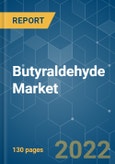The market for Butyraldehyde is projected to register a CAGR of more than 5% during the forecast period (2021-2026).
COVID-19 has negatively impacted the butyraldehyde market. Manufacturing activities were halted due to supply chain disruptions and labour shortages or as a protective measure to stop the spread of virus, thereby negatively affecting the market. Various end-user industries such as agrochemicals, paints & coatings witnessed some major issues due to the COVID-19 pandemic, including the effects of nationwide lockdown, companies moving to source away from China, thereby effecting the market on a short term basis. Butyraldehyde is used as an intermediate in the production of the coatings, the fall in production of coatings has declined the demand for butyraldehyde. However, the market growth is expected to recover in 2021 with the uplift of lockdown and resumed work in many end-user industries.
Key Highlights
- Over the long term, The increasing application in the paints and coatings sector has been driving the market growth.
- However, the health hazard, as well as environmental threats through direct contact of butyraldehyde and outbreak of coronavirus across the globe, are likely to hinder the growth of the studied market.
- The growing application of butyraldehyde in the pharmaceutical and agrochemical sectors is likely to provide opportunities for the butyraldehyde market over the next five years.
- N-Butanol is the most dominating product type of market studied.
- Asia-Pacific dominated the market across the globe with the largest consumption from countries such as China and India.
Key Market Trends
N-Butanol to Dominate the Market
- N-Butanol stands to be the dominating segment owing to extensive demand from paints and coatings applications in various end-user industries.
- N-Butanol is used as an ingredient in the manufacturing of acrylates that are then used in the production of paints and coatings, adhesives, textiles, and others. Increasing demand for such products from different end-user industries is likely to result in demand pulling from every phase of the value chain, thus driving market growth studied
- Production of paints and coatings is steadily increasing on the world market due to its demand from the applications of construction, and industrial coating. According to the Institution of Civil Engineers (ICE), The global construction industry is anticipated to reach USD 8 trillion by 2030.
- According to Worlds Paint and Coatings Industry Association, in 2020 the global sales volume of paints and coatings stood around USD 167.6 billion. The Paints and Coatings market is expect to project a CAGR of near to 3% till 2026.
- Adhesives demand is also rising, driven majorly by the growing construction and infrastructural activities, and increasing the need for furniture.
- All the aforementioned factors are expected to drive the butyraldehyde market during the forecast period.
Asia-Pacific Region to Dominate the Market
- Asia-Pacific accounted for the major market share and is expected to continue dominating the market during the forecast period.
- The key factors driving the Asia-Pacific market are positive trends for paints and coatings in India and China owing to the increasing investment in the construction industry.
- Asia-Pacific region accounts for around 50% of global consumption on a volume basis of paints and coating. The Asia-Pacific paints and coating market is estimated to witness significant growth at an estimated CAGR of over 5%, over the forecast period
- In the Asia-Pacific region, China accounts for the largest market share in butyraldehyde consumption. Demographics in the country are expected to continue to spur the growth in residential construction. Rising household income levels combined with population migrating from rural to urban areas are expected to continue to drive demand in the country's residential construction sector. Increased focus on affordable housing by both the public and private sectors may drive growth in the paints and coatings.
- The Chinese fertilizer market is growing at a very slow and steady rate, owing to the government regulation of zero residues of inorganic fertilizer in the food crops since 2013. The large production of cereal crops, like rice and wheat in India, is the major factor supporting agrochemicals market growth.
- Hence, all such market trends are expected to drive the demand for the butyraldehyde market in the region during the forecast period.
Competitive Landscape
The global butyraldehyde market is fragmented in nature owing to the presence of numerous players in the market with no significant market share. Some of the major companies are Mitsubishi Chemical Corporation, Tokyo Chemical Industry Co., Ltd., KH Neochem Co., Ltd, Eastman Chemical Company, and BASF SE amongst others.
Additional Benefits:
- The market estimate (ME) sheet in Excel format
- 3 months of analyst support
This product will be delivered within 2 business days.
Table of Contents
Companies Mentioned (Partial List)
A selection of companies mentioned in this report includes, but is not limited to:
- Alfa Aesar, Thermo Fisher Scientific
- Aurochemicals
- BASF SE
- DuPont
- Eastman Chemical Company
- GELEST, INC.
- KH Neochem Co., Ltd
- LobaChemie Pvt Ltd
- Mitsubishi Chemical Corporation
- Merck KGaA
- Tokyo Chemical Industry Co., Ltd.
- Toronto Research Chemicals
Methodology

LOADING...








